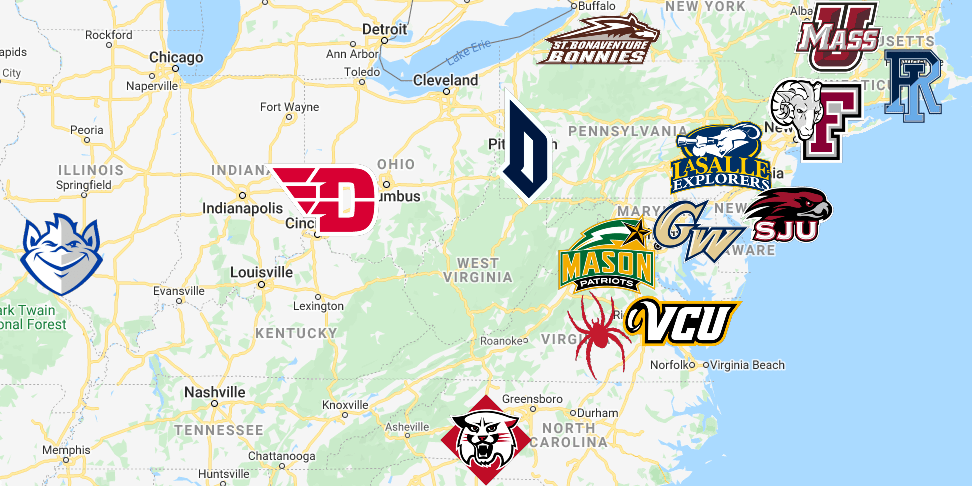

Over the past few articles, we’ve aimed to chart potential paths for the future of W&M Athletics. From pursuing the Patriot League to remaining in the CAA — and now: to pursuing the A10 — a conference William & Mary was a part of from 1993-2006.
Faced with strong opinion on all sides of these pathways, we at the WMSB believe it to be a “must-have” discussion nonetheless. This is an informative debate that should include not only older W&M alums, but also current students and recent alums.
Over the past year, W&M’s Athletics Department has experienced some serious turmoil at the Athletic Director position; seemingly, W&M’s prior AD Samantha Huge pursued a path that potentially could have led to W&M joining the A10 (in all sports except football). We’ll call it, the Richmond model. But is this the holistically agreed-upon goal: that W&M should pursue perceived “greener pastures?” OR is it that the CAA is, in fact, the greenest pasture that W&M should pursue?
Notice the explicit use of the word “should” in the second sentence.
But before getting into the nitty gritty, let’s first remind everyone which schools are in the Atlantic 10.
In addition to the map above, below is the written list:
- Davidson
- Dayton
- Duquesne
- Fordham
- George Mason
- George Washington
- La Salle
- UMass
- Rhode Island
- Richmond
- St. Bonaventure
- Saint Joe’s
- St. Louis University
- VCU
The conference is comprised of a geographically dispersed, yet relatively close set of respected universities. The A10 boasts 21 total sports (9 men’s and 12 women’s sports) — notably, the A10 does not include football. For reference, William & Mary fields 23 sports; a couple sports that the A10 does not field include the aforementioned football, as well as gymnastics.
Moreover, the A10 includes two women’s sports that W&M does not currently maintain, that being softball and women’s rowing; the A10 also does not maintain women’s golf, which W&M does.
With that in mind, schools such as Richmond and Rhode Island get around the “no football issue” by maintaining alignment in the CAA for football, but membership in the A10 for all other sports.
Despite the drawbacks, many ardent Green & Gold supporters view the A10 as a best-case-scenario of sorts for William & Mary; joining the A10 would automatically raise W&M’s basketball program(s) to new heights, as the the A10 regularly has multiple teams qualify for (and win in) the NCAA Tournament each year (as opposed to the CAA’s single, typically losing, entrant).
However, just joining the A10 would not automatically make William & Mary a basketball powerhouse, as the Tribe would then have to compete against far stronger basketball schools each year. And that’s probably an understatement. Even assuming W&M would be allowed to follow the Richmond model (staying in the CAA for football)…would it be worth it for W&M when looking at the bigger picture?
Just because A10 basketball is several notches above the CAA, is it a better conference across all of the sports that W&M offers? Also, the A10 does not carry gymnastics or women’s golf. We all saw what happened when W&M attempted to cut sports programs last year. That didn’t work out so well.
Either way, most folks’ currently believe that W&M wouldn’t even be considered for the A10 unless it were able to string together 2-3 NCAA Tournament appearances, establishing itself as a new basketball power by sustaining some semblance of success.
And while we love Dane Fischer, that type of success takes years of recruiting, cultural overhaul, and system implementation, among other factors. Plus, most schools aren’t part of the “Sad 4” original D-1 teams never to have made the NCAAT — so that doesn’t help. Despite that sentiment, the path is certainly there. Coach Fischer can certainly make this a reality. And if that were to be the case, not only is Richmond (W&M’s oldest, most important rival) in the A10, but so are fellow in-state rivals George Mason and VCU. Ah, remember those days back in the CAA?
W&M fans will fondly remember many-a-game against GMU and VCU. After experiencing immense success in basketball, both the Patriots and Rams made the “jump” from the CAA to the A10 about 10 years ago (wow, I’m getting old). But it also helped that neither of those schools had football programs, which of course, further complicates the situation for W&M.
But what might be the most important question(s) of all: is this a path W&M is BOTH willing and able to pursue…even if it actually wanted to? Not to beat a dead horse, but former W&M AD Samantha Huge’s plan included an emphasis on football and men’s & women’s basketball — her main goal was to increase the winning percentage of these “money & awareness-generating” sports.
However, was Huge wrong about: 1) The WAY she went about implementing her strategy, i.e. cutting other sports to help sustain the “Big 3” OR 2) Was it her overall dedication to winning in the “BIG 3” in the first place (perhaps at the expense of high academic recruiting standards) OR 3) Was it BOTH of the above?
We’ve just published a poll for W&M fans with the three choices above, plus a “None” option; join our Facebook group and vote in the poll at the link here! This question NEEDS to be answered.
This is the larger discussion that we have hoped to spur among the larger William & Mary community over the past month. We’ve not published our Patriot League, CAA, and now A10 articles to make anyone angry. This is a genuine, serious discussion that needs to be had at every level of W&M Athletics — from the fans and alums all the way up to the President of the school (who is, indeed, the Athletic Director’s boss).
We bold #’s 1-3 above in order to emphasize their importance. Whoever becomes the next Athletics Director at William & Mary (slated for hire this year in 2021), he or she will need to be more than aware of each individual path, and determine which one is best for the school as a whole.
If anything, these articles are intended to get a jump-start on some of the legwork the new AD will inevitably have to conduct upon entry; hopefully they see these articles as “required readings” coming into the job. But more important than the articles themselves is the discussion that’s occurring all over our social media channels.
CHIME IN! Let us know what you think. As stated, there are strong opinions on all sides of each aisle. But what’s undoubtedly true is that we live in an ever-changing world. In the near future of collegiate sports alone, the incoming AD will have to deal with monumental items such as: new College Athletic Name/Image/Likeness (NIL) law passed down from the Supreme Court, the never-ending college facilities arms race, recruiting, constant conference realignment, and ongoing financial management, just to name a few.
If you haven’t joined our Facebook group to comment yet (link just below!), that’s undoubtedly the best place to hold long-form discussions with other Tribe super fans. Also dropping a comment others can respond to on any of our social outlets has been known to spark an intelligent conversation or two.
When it’s all said and done, and however it shakes out for our Green and Gold, we at the WMSB are proud to call you an alum and/or friend of the College. It may be a tough hill to climb over the coming years, but we’ll be climbing right there with you rooting on our beloved William & Mary.
LET’S GO TRIBE.





Rutgers University, admittedly a much larger school than W&M, joined the Big 10 in 2012. The school was targeted by the conference given its location in the largest media market in the US. In 2025, the school’s share of media revenue will hit $60 million per year. $10 million more than the latest fund raising campaign – on an annual basis. This type of money funds both athletic and academic advancements on campus. It builds football stadiums and classrooms, basketball arenas and dorms, etc.
The question is not whether W&M should join the Patriot League, the A10 or stay in the CAA. The question is do we move into the ACC. Joining the ACC is an investment in W&M and Southeastern Virginia. It should be part of a larger effort to prepare the College and its community for the future. Also included in this effort are establishing a medical school, establishing an engineering school, and pursuing membership in the AAU. W&M should establish medical and engineering schools that are not only degree granting institutions, but are centers of excellence in conducting research on emerging medical and engineering topics. Joining the AAU will enhance the College’s reputation as a research university, like it has for its peers in Charlottesville and Raleigh.
These athletic and academic programs drive dollars into the endowment fund. The endowment fund invests further into the College and its students. Consider how NYU’s endowment is able to provide a tuition-free medical education. What W&M should not sacrifice in this plan is its focus on teaching. A balance must be struck that allows the College to retain its unique identity, pursue its mission, and prepare to grow for the future.
Why would the ACC accept W&M? Because if it doesn’t, the UVA and Tech will leave the conference at the Governor’s request. This deal was struck once before when Tech wanted in the ACC. Tech in particular has flourished in the conference, not only as a football team, but as a national university with a reputation for excellence rivaling Georgia Tech.
We can achieve much with such a strategy.